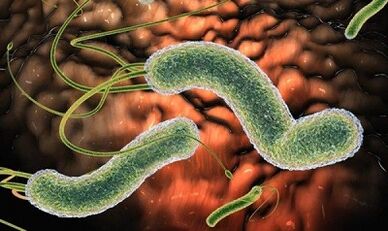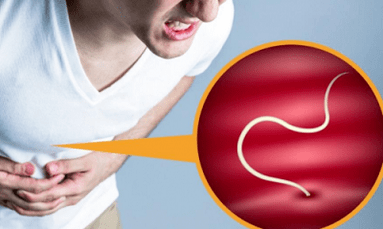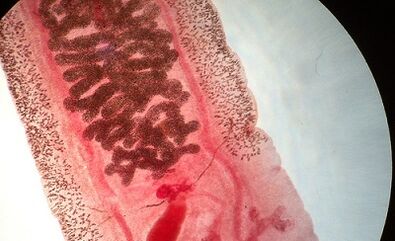
Among the patients, a serious misconception is that helminth is only living in the intestines.However, one cannot deny the fact that parasites in human blood are as broad as other types of helminthias.Timely identification and therapy of the pathological condition requires special attention, as when entering the bloodstream, a small socket can completely hit the organ.
Symptoms and painful sensations that cause worms in the blood in humans can differ in their manifestations and levels of severity.It is important to initiate timely treatment and prevent further spread of parasites on the human body to prevent timely complex effects.Initially, it is necessary to know how worms appear in the blood.
The type of parasite that sets blood flow
There is nothing so complicated by the production of the correct differentiation diagnosis as a major spread of the real symptoms in patients with parasites in the blood.Different types of helminths cause different signs.In the case of worm infections with blood or blood vessels, the patient should undergo a complete medical examination that will help identify the type of parasite and determine adequate treatment of pathological conditions.
There are several parasites that can live in human blood:
- Babesia;
- malaria plasmodium;
- Tripanosoma;
- ankylostoma;
- Trichinella;
- Toxoplasma;
- Toxkara.
Most helminths enter the human body after the insect bites.Parasites such as the blood circulatory tract are the most dangerous for children.They affect proper organ development, the growth of the whole organism and the condition of the immune system.Many people can live with parasites for years and do not suspect that they are infected.
General symptoms of parasitic blood poisoning
Each type of individual parasite in the human blood has symptoms that are characteristic only for this disease.
However, there are some features of any kind of helminthosis:
- Disadvantages;
- dizziness, headache;
- nausea, vomiting;
- It is possible to increase the amount of body temperature;
- pain in the limbs and all the body;
- Attack of consciousness is possible.
All of these symptoms are a major manifestation of increasing the content of toxic substances in the body.Initially their appearance, it is necessary to contact a medical institution where the doctor will conduct all the necessary tests and diagnostic procedures, which will most accurately determine the cause of such a condition.
Babesiosis: symptoms, diagnosis and treatment
Babesia is a small parasite that enters the human body after biting the ixodic sign.These simplest organisms quickly penetrate the erythrocyte membrane inside and start a difficult life cycle.The disease is widely used in warm areas where the Ixodes clan pests live.
In most cases, the disease continues without obvious symptoms in both adults and children.
However, when the disease appears and continues to develop, the features of the features are observed:
- hemolytic anemia;
- fever up to 39-40 degrees;
- chills;
- Increased sweating.
The same symptoms appear no later than 4 weeks after the bite of the sign.After the incubation period, the opportunity to identify the disease is much higher.
The disease can only be diagnosed in specific laboratory conditions.For this reason, there is not much data on the spread of the disease and the symptoms.
However, the attending physician should take some steps to identify the pathogen's foreign agents in the patient's body:
- general blood tests;
- Serological tests for antibodies to women;
- polymerase chain reaction;
- Microscopic examination of blood smear (coloring by Hymse).
Treatment is performed primarily with antiprotozoal drugs.Usually, the journey takes the fund for no more than 10 days, but can be continued in patients with recurrent forms of illness.Asymptomatic patient treatment is performed only when the causative agent of babusiosis is detected in the blood during re -analysis, which is performed several months after early detection, when the disease is recurrent.
Tripanosomosis: symptoms, diagnosis, treatment

Tripanosomosis, or drowsiness, spreads in countries in tropical and subtropical climate and is rarely found in moderate latitude.The agent that causes the disease is trikanosom.This is a small parasite.After looking at the parasite photos made using an electron microscope, you can distinguish flagella and membranes throughout the whole body.
Its disease and symptoms develop in two full stages.In the first stage, parasites penetrate human red blood cells and begin their active reproduction.
This level can be recognized by the following signs:
- fever attacks for up to 7 days;
- headache, weakness;
- joint pain and limbs;
- severe itching;
- The appearance of red cocoons at the site of the inflamed lymph nodes.
In the second stage of the disease, trikanosoms penetrate the central nervous system through the hematerfalic obstruction.This stage is characterized by a serious sleep cycle and a serious awake - the main symptoms of the disease.
In addition, in patients in the second stage of sleepy illnesses may appear:
- blurred awareness;
- trembling muscles, weakness;
- paralyzed limbs;
- an indifference;
- irritation;
- Invasion in relation to others.
It is necessary to start treatment as soon as possible, otherwise it is not the best result.In progress, the disease leads to the appearance of organ failure several body systems at once, as a result of the patient's death.
The diagnosis of drowsiness is based on the symptoms of patient and microbiological studies for the presence of tripanos in the blood, lymph and purulent fluid taken from shancra.With positive samples, treatment is prescribed immediately.
Good prognosis can be made when the disease can be detected at the hemolytic stage.Currently, relatively toxic drugs are prescribed, but in general, the treatment is well received by the patient's body.
However, when the disease can recognize only in the second stage, prognosis is not always entertaining.To treat such pathological conditions, it is necessary to use serious and toxic drugs that can penetrate the protective barrier of the central nervous system.
Malaria: symptoms and treatment

Infections with malarial plasmodium occur through mosquito bites.Through the female salivary gland, parasites penetrate a person's blood flow, transferred with blood flow into the liver, where the first stage of metamorphosis passes, and again enters the bloodstream and affects red blood cells.
The incubation period lasts up to 25 days.Then the first symptom of malaria is indicated:
- significant increase in body temperature;
- headache, weakness;
- hemolytic anemia;
- Yellowness skin;
- nausea, vomiting;
- joint pain, pain throughout the body;
- seizures;
- The appearance of red blood cell destruction products in urine.
Basically, the disease is extensive in warm and hot areas, so the diagnosis is based solely on the symptoms and life history of the patient shown over time.Regular trips to the equatorial country can lead to the development of the disease.In addition, standard blood tests and microbiological examination of body fluid are performed.
The therapy is prescribed depending on the type of disease and its severity and is performed primarily using antimalarial drugs.
Ankylostomosis: symptoms, diagnosis and treatment
The parasites that cause the disease to survive in the intestinal genes and eat your blood cells.Worms penetrate one's skin and begin to emigrate into the intestines.In the process of moving around the body, parasites with blood flow fall into the lungs, then pass along the bronchus in the trachea and upper respiratory tract, where they trigger a swallow reflex, and thus reach the intestine, on the designated wall.
In rare cases, worm worms cannot successfully resolve their migration and remain under one's skin.In the photo, the same process resembles a small and thin snake under the patient's skin.

Eating blood, worms causes the development of iron deficiency anemia in infected people.Most dangerous when worms penetrate the body of children.Iron deficiency, protein and other components needed for children's development can lead to mental delay, recent growth and physical low.
The main symptoms of ankylostomosis:
- Iron deficiency anemia;
- fever attacks;
- pain in the stomach;
- nausea, vomiting;
- diarrhea, constipation;
- severe weight loss;
- Cough, infectious diseases of the upper respiratory tract during migration of parasitic larvae.
Among the steps -diagnostic steps, general blood tests, stool and urine analysis, ultrasound examination of the digestive system is distinguished.The identification of parasites is a good reason to initiate immediate treatment and prevention of pathological conditions related to the functioning of the respiratory system disorders, digestion and blood circulation.
Treatment is carried out by the use of an anthelmintic drug.Therapy is supplemented by the use of complex vitamins and minerals, which allows for smoothing due to hemoglobin deficiency.
Toxocarosis: symptoms and treatment
The agent that causes the disease is a round helminths, which one can get after prolonged communication with a pet that has not passed Deworming, while eating vegetables and non -washed fruits.The human body hosts the intermediary of the parasite.
Enter the intestine, the larvae hatch from the egg and begin to "drill" the intestinal wall, penetrating the blood flow.With blood flow, helminths emigrated to any human body system.The results of the worm migration are defective liver, liver, central nervous system and vision organs.

The main symptoms of toxocracles body infection:
- increase the amount of body temperature;
- the appearance of severe pain in the stomach;
- weakness, dizziness;
- the appearance of allergic rash on the skin;
- strong cough at night;
- Seizures, muscles and joint pain.
The diagnosis of the disease is quite difficult.It is necessary to conduct a microbiological test, a serious allergy to which a specialized laboratory is required:
- polymerase chain reaction;
- Immunosorbent analysis;
- Serological tests;
- organ ultrasound examination;
- Magnetic resonance and computed tomography.
Serious anthelmintic therapy is only performed when severe damage to the brain is detected, the patient's heart muscle.Often the disease passes freely, as the larvae level cannot develop into an adult individual in the mid -host body.
However, it is necessary to take into account the harm that the worm moves can cause the patient.It is necessary to carry out support therapy and take the steps needed to prevent the development of serious pathological processes in the liver, cardiovascular and other organs.
Conclusion
Any parasites are dangerous to the human body.If the question arises, "what parasites live or use blood as a transportation system", "how to determine it properly or not", "how to treat it and what to take", then it is best to contact parasitologists, and do not make free decisions.Treatment and prevention of parasitic disease is a decision that a qualified doctor should take.



























